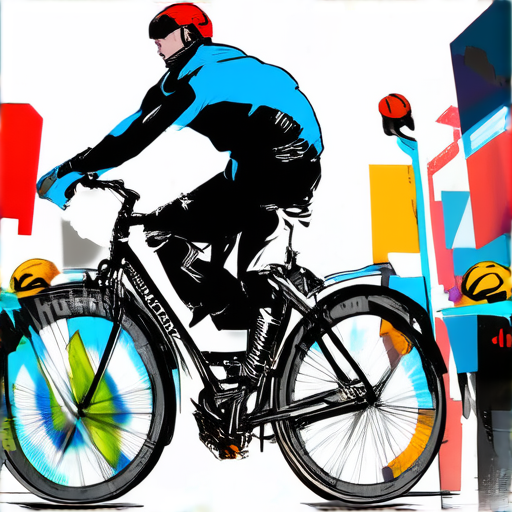Essential Bike Safety Equipment for a Safer Cycling Experience is crucial for protecting cyclists from potential hazards and reducing the risk of accidents. By understanding the importance of safety equipment, cyclists can take proactive steps to ensure their well-being on the road. From helmets to knee pads, there are numerous types of safety gear available that cater to different age groups, riding styles, and preferences. In this comprehensive guide, we’ll explore the essential safety equipment for bikes, discuss the best safety features, and provide valuable tips on how to choose the right gear for a safer cycling experience. Whether you’re a seasoned cyclist or a beginner, this article aims to equip you with the knowledge and confidence to ride safely and enjoyably.
Safety Equipment You Should Have on Your Bike
When it comes to cycling safety, having the right equipment can significantly reduce the risk of accidents and injuries. Here are some essential safety items you should consider carrying on your bike:
Essential Safety Items for Cycling
- Bicycle Safety Gear for Kids
- Bell or Horn
- Reflective Clothing
- Front and Rear Lights
- Rearview Mirror
- First Aid Kit
- Basic Tool Kit
- ID and Emergency Contact Information
These safety items can help protect you from various types of hazards, such as collisions with vehicles, falling off your bike, or getting injured due to poor road conditions. By incorporating these essential safety items into your cycling routine, you’ll be better protected against the risks associated with cycling. Always remember to follow local traffic laws and ride defensively to minimize your exposure to potential hazards.
What Safety Equipment Should Be On Your Bike?
Bike safety equipment is an essential aspect of cycling, and it’s crucial to have the right gear to minimize the risk of accidents and ensure a safe riding experience.
Best Safety Measures for Bikes
When it comes to bike safety, there are several essential measures to take to minimize the risk of accidents and ensure a safe riding experience. Here are some critical safety tips:
- Wearing Protective Gear: Wearing protective gear is one of the most effective ways to prevent injuries while cycling. A bike helmet is a must-have, as it can significantly reduce the risk of head injuries in case of a crash. Additionally, wear bright and reflective clothing during the day and night to increase visibility to motorists.
- Lighting and Visibility: Proper lighting is crucial for increased visibility, especially at night or in low-light conditions. Install white front lights and red rear lights on your bike, along with reflectors on the wheels and pedals. This will help you be seen by motorists and reduce the risk of being involved in a collision.
- Bike Maintenance: Regular maintenance of your bike is vital to ensure it is in good working condition. Check the brakes, tires, and chain regularly to avoid mechanical failures that could lead to accidents.
- Riding Habits: Develop good riding habits to stay safe on the road. Ride defensively, follow traffic rules, and anticipate potential hazards such as potholes, debris, and vehicles turning into your path.
- Visibility Markings: Consider adding visibility markings to your bike, such as stickers or decals, to increase its visibility to motorists. These markings can be particularly useful for cyclists who ride at night or in low-light conditions.
- Cycling Courses and Training: Take advantage of local cycling courses and training programs to learn advanced riding skills and techniques. These courses can teach you how to handle different types of terrain, navigate obstacles, and respond to emergency situations.
- Helmet Fit and Certification: Ensure that your bike helmet fits properly and meets safety standards set by organizations such as the Consumer Product Safety Commission (CPSC) or Snell Memorial Foundation. Look for helmets with certification marks or labels indicating compliance with these standards.
- Road Conditions and Infrastructure: Be aware of road conditions and infrastructure that may pose hazards to cyclists. Report potholes, uneven pavement, and other hazards to local authorities to ensure they are addressed.
- Weather Conditions: Adjust your riding schedule according to weather conditions. Avoid riding in heavy rain, strong winds, or extreme temperatures, which can affect your visibility and control over the bike.
- First Aid Kit: Always carry a basic first aid kit with you while cycling, containing essentials such as bandages, antiseptic wipes, and pain relievers. In case of an accident, having a first aid kit nearby can help you treat minor injuries promptly.

**Best Protection for Cycling**
Cycling protective clothing and armor have become essential components for cyclists seeking to minimize risks and prevent injuries during rides. At Leeds Bicycle, we understand the importance of having the right gear to stay safe on the road.
Key Aspects to Consider
1. Helmet Safety Standards: Look for helmets that meet safety standards set by organizations such as Snell Memorial Foundation, CPSC (Consumer Product Safety Commission), or EN (European Standard). These standards ensure that the helmet provides adequate protection against head impacts.
2. Knee and Elbow Pads: Knee and elbow pads offer crucial protection for joints vulnerable to impact. Choose pads made from durable materials, such as Kevlar or hard-shell plastics, which can absorb shocks and distribute force evenly.
3. Gloves: Cycling gloves provide grip, comfort, and protection for hands. Opt for gloves with reinforced palms, fingers, and wrists to shield against road rash and abrasions.
4. Shin Guards: Shin guards protect the lower legs from road rash and other impacts. Select shin guards made from lightweight, breathable materials that won’t restrict movement.
5. Back Protector: A back protector offers vital protection for the spine and torso. Consider a back protector specifically designed for cycling, which typically features a rigid shell and padding for optimal coverage.
6. Visibility and Reflectivity: Enhance visibility and reflectivity by incorporating reflective strips, bright colors, or high-visibility fabrics into your protective gear. This helps increase visibility to motorists and reduces the risk of accidents.
7. Fit and Comfort: Ensure a snug, comfortable fit for all protective gear to prevent chafing, irritation, or restricted movement. Regularly inspect and maintain your protective equipment to guarantee optimal performance.
8. Certification and Compliance: Verify that your protective gear meets local regulations and certification requirements. For example, in the United States, the Consumer Product Safety Commission (CPSC) sets standards for bicycle safety equipment.
9. Maintenance and Inspection: Regularly inspect and maintain your protective gear to ensure its effectiveness. Check for signs of wear, damage, or degradation, and replace worn-out parts promptly.
10. Additional Features: Some protective gear may feature additional features, such as built-in lights, phone mounts, or hydration systems. Consider these features when choosing your protective gear, as they can enhance overall riding experience and safety.
The Most Important Safety Gear a Cyclist Can Wear
As a cyclist, wearing the right safety gear is crucial to minimize the risk of injury or fatality in case of an accident. While a helmet is essential, there are several other critical pieces of safety equipment that cyclists should consider wearing.
Eye Protection
Wearing eye protection, such as goggles or glasses with shatter-resistant lenses, can help prevent eye injuries caused by debris, wind, or road hazards. According to the American Academy of Ophthalmology, “eye injuries are a leading cause of blindness among cyclists” (American Academy of Ophthalmology, 2019).
Knee and Elbow Pads
Knee and elbow pads can provide additional protection for joints in case of a fall. These pads can help absorb impact and reduce the risk of serious injury. The National Highway Traffic Safety Administration recommends wearing knee and elbow pads when riding in high-risk environments, such as construction zones or rough terrain (National Highway Traffic Safety Administration, 2020).
Reflective Clothing
Wearing reflective clothing, especially at night or in low-light conditions, can increase visibility and help prevent accidents. Reflective materials, such as strips or vests, can be attached to clothing or accessories, making it easier for drivers to see cyclists (Federal Highway Administration, 2020).
Lights and Mirrors
Installing lights and mirrors on the bicycle can enhance visibility and provide an added layer of safety. Front and rear lights can alert drivers to the presence of a cyclist, while mirrors can allow riders to check blind spots and anticipate potential hazards (League of American Bicyclists, 2020).
Proper Fitting and Maintenance
Ensuring that safety gear is properly fitted and maintained is crucial to its effectiveness. A well-fitted helmet, for example, can significantly reduce the risk of head injury (Consumer Product Safety Commission, 2018). Regularly checking and maintaining safety gear can help ensure that it remains effective and functional.
Protecting Your Balls While Cycling
As a cyclist, protecting your testicles from discomfort and potential injury is crucial during long rides.
Protecting Your Balls While Cycling
Choosing the Right Bike Seat is essential to reduce pressure on your testicles. Opt for a bike seat with adequate padding and a cutout to distribute the weight evenly.
- Consider a bike seat with a gel or foam insert for extra comfort.
- Soft saddles can help reduce friction and discomfort.
Wearing Protective Gear can significantly reduce friction and discomfort. Look for padded cycling shorts made from breathable, moisture-wicking materials.
Maintaining proper riding position is also crucial. Sit up straight and avoid leaning forward, which can put unnecessary pressure on your testicles.
Additional Tips for Comfortable Cycling
Take regular breaks to stand up and stretch, giving your testicles a chance to rest. This simple habit can greatly reduce discomfort and prevent injury.
Using Full Suspension Bikes can absorb shock and vibrations, reducing the impact on your testicles.
Stay hydrated and focused during your ride. Drink plenty of water before, during, and after your ride to stay hydrated.
Avoid distractions while riding, focusing on the road ahead and maintaining proper posture.

What Is the Most Common Reason for Cyclist Fatalities?
Cyclist fatalities are a significant concern worldwide, with numerous factors contributing to these tragic events.
Most Common Reason for Cyclist Fatalities
Collisions with motorists are the leading cause of cyclist fatalities, accounting for approximately 85% of all bicycling-related deaths in the US, according to a study published in the Journal of Injury Prevention.
Statistics and Data
- National Highway Traffic Safety Administration (NHTSA) reported over 817 bicyclist fatalities in the United States alone in 2020.
- A study published in the Journal of Injury Prevention found that between 2015 and 2019, motor vehicle collisions accounted for approximately 85% of all bicycling-related deaths in the US.
Causes of Collisions
Several factors contribute to collisions between cyclists and motorists, including:
- Lack of visibility: Cyclists may not be visible to drivers, especially when traveling at night or in low-light conditions.
- Inadequate infrastructure: Insufficient bike lanes, poor road design, and lack of separation from motorized traffic increase the risk of collisions.
- Driver behavior: Aggressive driving, speeding, and failure to yield to cyclists can lead to fatal crashes.
- Equipment failure: Defective bicycles or helmets can compromise a cyclist’s safety.
Prevention Strategies
To reduce the number of cyclist fatalities, several prevention strategies can be employed:
- Improved infrastructure: Investing in dedicated bike lanes, improved road design, and increased visibility can help minimize the risk of collisions.
- Education and awareness: Educating cyclists and motorists about safe riding practices and sharing the road can significantly reduce the number of accidents.
- Helmet use: Ensuring that cyclists wear properly fitted helmets can greatly reduce the severity of head injuries in the event of a crash.
Research and Trends
Recent studies have highlighted the importance of addressing the root causes of cyclist fatalities. A review of literature published in the American Journal of Public Health found that interventions focusing on infrastructure improvements, education, and enforcement of traffic laws can effectively reduce cycling-related fatalities.

0 Comments